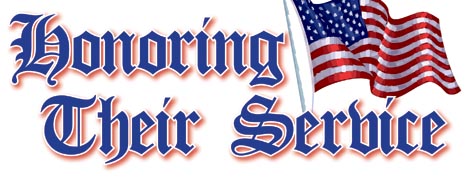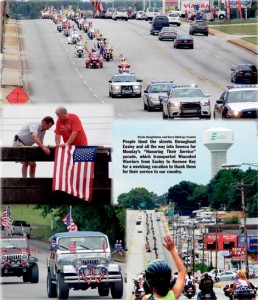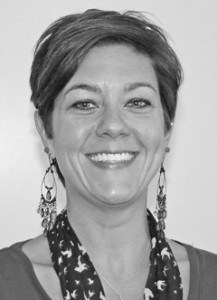Honoring Their Service

About Wounded Warriors Project
The mission of the Wounded Warriors Project (WWP) is to honor and empower the men and women who have been injured in service to their country and foster the most successful, well-adjusted generation of wounded service members in our nation’s history.
The WWP works diligently to raise awareness and enlist the public’s aid for the needs of injured service members, to help injured servicemen and women aid and assist each other, and to provide unique, direct programs and services to meet their needs.
Headquartered at the Sacrifice Center in Jacksonville, Fla., additional program offices are located throughout the United States and specific locations can be found at woundedwarriorproject.org.
HISTORY
The Wounded Warriors Project (WWP) began when several veterans and friends, moved by stories of the first wounded service members returning home from Afghanistan and Iraq, took action to help others in need. What started as a program to provide comfort items to wounded service members has grown into a complete rehabilitative effort to assist them as they recover and transition back to civilian life. Tens of thousands of Wounded Warriors and family members receive support each year through WWP programs designed to nurture the mind and body, and encourage economic empowerment.
The Wounded Warrior Project serves veterans and service members who incurred a physical or mental injury, illness or wound as a result of their military service on or after Sept. 11, 2001. WWP also aides the families of these military veterans and service members.
America watched in horror as approximately 3,000 people died — including hundreds of firefighters and rescue workers — during the 9/11 terrorist attacks.
Sept. 11, 2001 also served as a stimulus for Operations Iraqi Freedom, Enduring Freedom and New Dawn. Operation Iraqi Freedom refers to military operations in Iraq that began March 19, 2003 and officially ended Aug. 31, 2010. Operation Enduring Freedom refers to combat operations in Afghanistan and other regions in support of the Global War on Terror. Operation New Dawn refers to the conclusion of operations in Iraq beginning Sept. 1, 2010 and ending Dec. 15, 2011.
For WWP, there is a distinct difference between members and alumni; the term alumni indicates a mutual shared experience and denotes the place in an organization was earned. There are no dues for WWP alumni; those were paid by wearing the uniform and on the battlefield.
As of May 1, 2013 there are 32,008 Wounded Warrior Program Alumni.
The WWP has also served 3,379 family members.
With advancements in battlefield medicine and body armor, an unprecedented percentage of service members are surviving severe wounds or injuries.
For every U.S. soldier killed in World Wars I and II, there were 1.7 soldiers wounded. In Operation Iraqi Freedom and Operation Enduring Freedom, for every U.S. soldier killed, seven are wounded. Combined, more than 48,000 servicemen and women have been physically injured in the recent military conflicts.
In addition to the physical wounds, it is estimated as many as 400,000 service members live with the invisible wounds of war including combat-related stress, major depression and post-traumatic stress disorder.
Another 320,000 are believed to have experienced a traumatic brain injury while on deployment.
There have been approximately 6,687 deaths.
50,684 service men and women have been wounded.
More grateful than ever for soldiers’ sacrifices
By Nicole Daughhetee
Monday was an exciting news day for me. I was sent to cover the announcement of the host team for Easley’s Big League World Series (BLWS). Later that afternoon, my assignment was to photograph the “Honoring Their Service” motorcade event that would begin in Easley and travel along Highway 123 until the parade ended at Keowee Key.
Knowing that the paper was depending on my photographs, I made certain I left my house early so I could scope out a great place to get pictures; I wanted the perfect vantage point, and I was parked in my picture-taking spot by 1:38 Monday afternoon.
The Wounded Warriors weren’t scheduled to pull out of the J.B. “Red” Owens complex until 2 pm, so I had time to spare.
As I sat in my car’s air conditioning, waiting to step out onto the sidewalk along 123 to complete my assignment, I thought about my week’s To-Do list, which included getting my oldest daughter to volleyball camp, beginning a painting project in my bedroom and continuing to work on quilt squares for my friend Kim, a missionary, who will be taking them on her trip to Haiti next month as part of her mission.
I also thought about how to edit the devotional Kim asked me to write — the one that will accompany the quilt squares being handed out to the Haitian families she will visit.
My thoughts drifted to my youngest daughter and what a neat experience it was for me to be able to take her with me on my earlier assignment. She has expressed an interest in wanting to play baseball and wanted to know why there were not any girls on the BLWS team roster that was announced earlier.
Eventually, it was time for me to grab my camera, note pad and get out of the car. A small group of on-lookers had arrived in my spot, and I wanted to ask them a few questions — gather a few quotes — before turning my attention to trying to capture artistic quality photographs.
It wasn’t until I was driving home from my assignment that I was struck with the epiphany I am about to share.
While I feel somewhat ashamed to admit this, I don’t think about our service men and women on a daily basis. I’m certain I’m not alone in this regard. Yet as I sit here, typing out the words for this story — words that will appear in the Pickens County Courier this week — I am able to do so because of the very men and women I photographed earlier this afternoon.
Were it not for their service, for their willingness to risk their lives, their physical and mental health and well-being, I would not have the freedom to sit in the comfort of my family room writing and sharing the thoughts that sweep through my mind.
Were it not for their service, my daughters would not have the freedom to enjoy playing volleyball or to question why girls aren’t on the BLWS team roster.
Were it not for their service, as a woman, I might not be afforded the same freedoms as men: the opportunity to work outside my home and provide for my daughters; the freedom to be independent in the manner I choose to dress or wear make-up or style my hair.
Were it not for their service, my daughters could be growing up in a war zone, plagued by the imminent fear of a firefight in the streets or bombs dropped overhead slicing the night silence as they sleep.
Were it not for their service, those young men I photographed on the ballfield wouldn’t have a ballfield to play on, nor would they have the freedom to play or be afforded the opportunity to represent their schools and communities as members of the team. Baseball is, after all, the great American past time.
If men and women were not willing to risk their lives every day in service to our country, my friend Kim wouldn’t be a missionary, because she might not have the freedom to follow her spiritual convictions.
On a purely intellectual level, I have known and understood for a long time that I have freedom because other people fought for me to have it and more still work tirelessly to ensure that those freedoms are protected. Today I came to comprehend that on a completely different, deeply heart-felt emotional level.
I’ve studied American history. I’ve read a lot of books. I watch and report the news. Horrible things happen every day, and we have men and women who put on a uniform every day and go to work without concern for their physical safety or mental well-being, so that I am protected from the terrorism rampant in other countries — the tyranny displayed on the six o’clock news.
Because of this I will never again take for granted the freedoms my family and I are guaranteed on a daily basis because of the men and women who are willing to risk their lives for me — a person they don’t even know — for an entire country full of people they know only as a collective and abstract body of Americans.
Though I don’t personally know these men and women, I am incredibly proud of them and everything they do. I am honored that they are willing to make such sacrifices for me and my family. “Thank you” does not seem a big enough, grand enough expression to convey how deeply grateful I am for their selfless service to our country.
Not only do they risk injury and death, but they also give up time with their loved ones — family and friends who worry about them and their safety while they are gone. They forfeit time with their families and friends while you and I are making memories with ours.
Every time I hug and kiss my daughters and tell them how much I love them, I will be mindful that somewhere there is a parent missing his child, a mother longing to wrap her arms around her baby, but instead they are doing their jobs so I can love on my children.
The men and women who are being honored this week at Keowee Key have not been unscathed. They carry the scars of physical and emotional wounds inflicted because of their choices to fight for you, for me, for all of us — people they don’t even know. People who, like me, have taken for granted the sacrifices they make on a daily basis so I won’t have to make them.
Honoring Their Service is an opportunity for our local communities to come together and say thank you — to show our respect and appreciation for the service men and women who ensure that we live in an America that is truly the land of the free and, without a doubt, home to these brave heroes.
Joseph Campbell wrote that “a hero is someone who has given his or her life to something bigger than oneself.”
These service men and women, these Wounded Warriors, are the living embodiment of what it means to be a hero.
For more information on the Wounded Warrior Program and how you can help, visit their website at http://www.woundedwarriorproject.org/





























